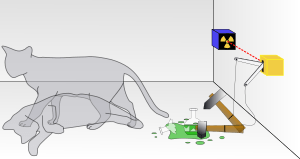Schrödinger's cat facts for kids
Schrödinger's cat is a famous thought experiment (a way of thinking through a problem) about quantum physics. It was suggested in 1935 by a scientist named Erwin Schrödinger. He created it to show some strange ideas that came from the Copenhagen interpretation of quantum physics.
In simple terms, Schrödinger said: imagine you put a cat and something that could kill it (like a tiny bit of radioactive material) inside a sealed box. Until you open the box, you wouldn't know if the cat was dead or alive. So, in a way, quantum physics suggests the cat is both dead and alive at the same time until you look!
Contents
Understanding Physics
Physics is the study of how the universe works. It can be split into two main types:
Classical Physics
This is the physics we see every day. It explains why a ball bounces when you drop it or how a car moves. It helps us predict what will happen with larger objects.
Quantum Physics
This type of physics explains how tiny things work, like the smallest parts of an atom. Classical physics can't explain everything, such as how light can be turned into electricity. Quantum physics helps scientists understand these very small interactions.
The Copenhagen Idea
The Copenhagen interpretation is a way to understand what happens to tiny particles (like parts of an atom) when we aren't looking at them.
Scientists use math to figure out how likely it is for a particle to be in a certain place or state. For example, a particle might have a 50% chance of being in one spot and a 50% chance of being in another. This can be shown as a "wave form" in math.
However, the only way to be 100% sure where a particle is, is to actually look at it or measure it. Until you observe it, the Copenhagen interpretation says the particle is in all its possible states at once. It's only when you observe it that it "chooses" one state.
This idea works well for tiny particles, but it doesn't seem to make sense in our everyday world.
The Cat Experiment
Schrödinger wanted to show that applying these quantum ideas to large, everyday objects would lead to very strange situations. So, he designed his famous thought experiment:
- A cat is placed inside a sealed room or box, completely cut off from the outside.
- Inside the room, there's a Geiger counter (a device that detects radiation) and a tiny bit of radioactive material.
- This radioactive material is very unstable. Within one hour, one of its atoms might break down (decay), or it might not. It's a 50/50 chance.
- If the material breaks down, it releases a tiny particle. This particle hits the Geiger counter.
- When the Geiger counter detects the particle, it triggers a hammer. The hammer then breaks a small flask of poison gas, which kills the cat.
Now, the big question is: at the end of the hour, is the cat alive or dead?
According to the Copenhagen interpretation, as long as the box is closed, the cat is both dead and alive at the same time. You won't know for sure until you open the box. But Schrödinger pointed out that by opening the box, you are interfering with the experiment. Your act of looking influences the outcome.
Schrödinger created this thought experiment to show how odd it would be to think of large objects, like cats, existing in multiple states at once. It has also been mentioned many times in movies, TV shows, and books!
Related pages
See also
 In Spanish: Gato de Schrödinger para niños
In Spanish: Gato de Schrödinger para niños



